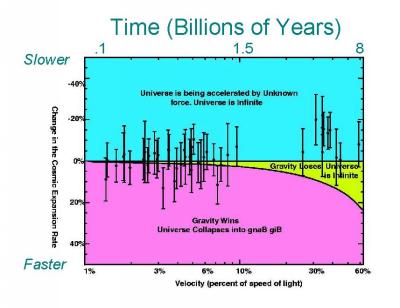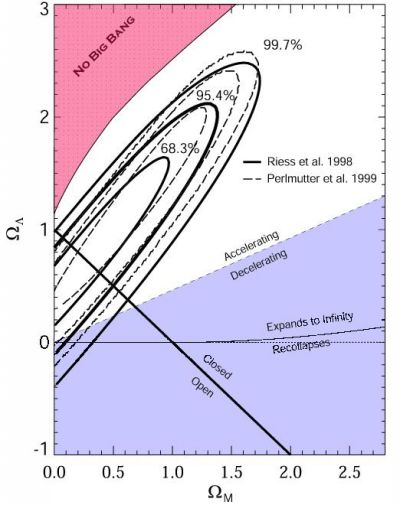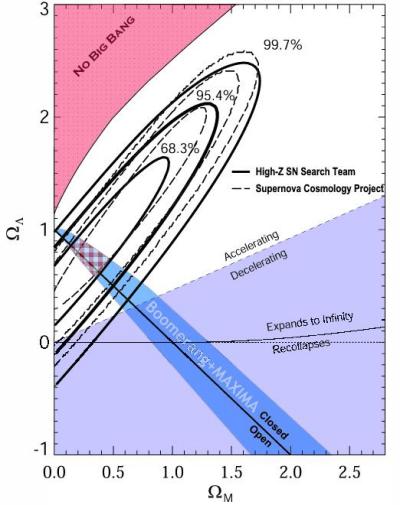Data and Discovery
 This plot shows our supernova data. Across the Bottom axis is Distance (or
equivalently time since the SN exploded). The side axis shows change in the Expansion
rate from its current rate. As you can see the points do not show the Universe slowing
down enough to have a gnaB giB. Furthermore, they do not even seem to show the
Universe coasting, rather they show that the Universe is accelerating!
This plot shows our supernova data. Across the Bottom axis is Distance (or
equivalently time since the SN exploded). The side axis shows change in the Expansion
rate from its current rate. As you can see the points do not show the Universe slowing
down enough to have a gnaB giB. Furthermore, they do not even seem to show the
Universe coasting, rather they show that the Universe is accelerating!
So what could make the Universe accelerate? It turns out one possibility is a form of
matter/energy invented by Einstein in the 1920s to make sure his equations of General
Relativity did not predict the Expansion of the Universe. Although Einstein was willing
to predict several things with his equations of General Relativity, he obviously thought an
expanding Universe was too much, and so he invented the Cosmological Constant, which
repels itself, and was meant to balance the force of gravity, and make the Universe static.
He later called this the greatest mistake of his life.
But starting in the 1980s, the Cosmological Constant has made resurgence as a cosmic
panacea. Although the Cosmological constant seems capable of curing many of the ills
of the modern cosmology such as the age problem: (A Universe with a lot of
cosmological constant is older than we might otherwise think, therefore making the age
from the Hubble Constant and the age of the oldest stars in agreement).
 Here we show how much cosmological constant and normal matter (that is the stuff you
and I and everything around us that we see is made out of) there is in the Universe. The
darker the color, the likely a particular combination of the two types of matter is. The
numbers are plotted as the greek letter Omega which is the symbol we use to represent
the fraction of the Universe made out of matter relative to the amount necessary to make
space flat. (i.e., if Omega = 1 then there is just enough matter to make the Universe flat).
As you can see, it appears that the total amount of normal matter in the Universe is quite
small - Omega is less than 1 for normal matter, and the amount of cosmological constant is
reasonably large - Omega greater than 0 for the cosmological constant.
Here we show how much cosmological constant and normal matter (that is the stuff you
and I and everything around us that we see is made out of) there is in the Universe. The
darker the color, the likely a particular combination of the two types of matter is. The
numbers are plotted as the greek letter Omega which is the symbol we use to represent
the fraction of the Universe made out of matter relative to the amount necessary to make
space flat. (i.e., if Omega = 1 then there is just enough matter to make the Universe flat).
As you can see, it appears that the total amount of normal matter in the Universe is quite
small - Omega is less than 1 for normal matter, and the amount of cosmological constant is
reasonably large - Omega greater than 0 for the cosmological constant.
Supernovae are not the only way to make such a diagram. Another way is to look at the
Universe when it was very young, and glowed like the sun. This radiation is the furthest
thing we can see in the Universe, and is known as the Cosmic Microwave Background.
By observing how the lumps and bumps in this background are distributed, it is possible
to measure the amount of matter in the Universe. New measurements from this method
give their own measurement of Matter and Cosmological Constant.
 If we combine the two measurement into one diagram, we can figure out what both methods together
are telling us right now. As you can see the best values (the hashed red and white area where the two methods
overlap) are having normal matter 0.2 of the critical value, and the cosmological constant about 0.8 of the
critical value.
If we combine the two measurement into one diagram, we can figure out what both methods together
are telling us right now. As you can see the best values (the hashed red and white area where the two methods
overlap) are having normal matter 0.2 of the critical value, and the cosmological constant about 0.8 of the
critical value.
This is actually quite amazing because many theorists want the sum of Omegas in all types of
matter to be one - this is the prediction of a theory called Inflation - and these results suggest that it just might be.
As mentioned earlier, we are one of two groups working on this project, and we have
arrived, using different data, to almost identical conclusions at the same time, without
knowledge of each other's results. The above diagrams show both teams data (they are the Supernova
Cosmology Project). But just because we get the same answer does not
mean we are both right, we could both be being fooled by our supernovae in the same
way. Or maybe our whole cosmological model is flawed.
So our observations may really mean one of three things:
The Exciting: the Universe is accelerating. The Universe is accelerated by some unknown type
of matter that is spread throughout the Cosmos.
The Heretical: General Relativity is as sacred as anything in Physics, but it may be wrong. Since
our work is comparing the predictions of General Relativity with observations, if General Relativity is
wrong, so are our conclusions.
The Mundane (at least from our point of view): We are simply wrong and have been
fooled by Supernovae into believing the Universe is accelerating. Maybe supernovae are fainter
in the past, and therefore look further away.
We hope and believe it is the first alternative, but we have to work hard and test to see if it
isn't the second or third alternative. Checking these two other alternatives is a major focus of
our current work.
|

